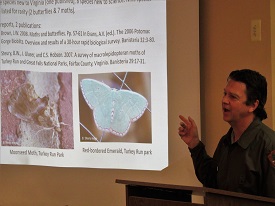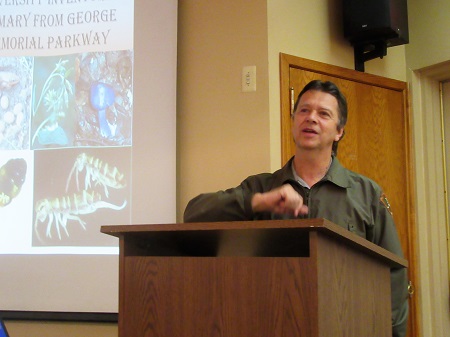On November 14, 2018, Brent Steury, Natural Resources Manager for the George Washington Memorial Parkway, told 65 FODMers and friends that the parkway is rich and biodiverse in its natural resources in a presentation describing the Parkway’s all-taxa inventory. The Parkway is a national park of which the Dyke Marsh Wildlife Preserve is a unit.
The numbers are steadily increasing so the numbers he gave on November 14 are not current. Still, they are impressive:
- 5,857 species documented.
- 142 species new to the flora or fauna of Virginia: 9 non-vascular plants, 22 vascular plants, 1 vertebrate (reptile), and 109 invertebrates (2 worms, 1 crustacean, 3 mollusks, 14 spiders, and 89 insects: caddisflies, bees, sawflies, moths, beetles, and true bugs).
- 7 species new to the District of Columbia (all beetles).
- 3 species new to North America (1 vascular plant, 1 worm, 1 true bug).
- 74 species new to science: 1 crustacean, 1 millipede, 37 springtails, 13 mites, 8 flies, 8 moths, 5 beetles, and 1 sawfly, plus possibly 30 nematodes new to science.
- 106 species state listed for rarity (47 vascular plants, 3 mammals, 24 birds, 3 crustaceans, 6 mollusks, 3 dragonflies, 2 butterflies, 7 moths, 10 caddisflies, and 1 beetle).
- 3 federally-threatened species (northern long-eared bat, red knot, piping plover).
 Brent Steury described the diversity of species so far identified on the 4,580-acre GWM Parkway.
Brent Steury described the diversity of species so far identified on the 4,580-acre GWM Parkway. Sixty-five people learned about the Parkway's all-taxa inventory.Some of the previously undocumented species were observed in Dyke Marsh. For example, on September 6, 2018, FODMer Ed Eder saw a rare dragonfly, the fine-lined emerald (Somatochlora filosa). Steury said that FODM volunteers’ dragonfly and damselfly surveys have added four new species to the Parkway’s records.
Sixty-five people learned about the Parkway's all-taxa inventory.Some of the previously undocumented species were observed in Dyke Marsh. For example, on September 6, 2018, FODMer Ed Eder saw a rare dragonfly, the fine-lined emerald (Somatochlora filosa). Steury said that FODM volunteers’ dragonfly and damselfly surveys have added four new species to the Parkway’s records.
Steury and his colleagues have published 70 peer-reviewed journal articles in the last 12 years.
For more information on the GWM Parkway, visit www.nps.gov/gwmp.
Photos contributed by Glenda Booth.


